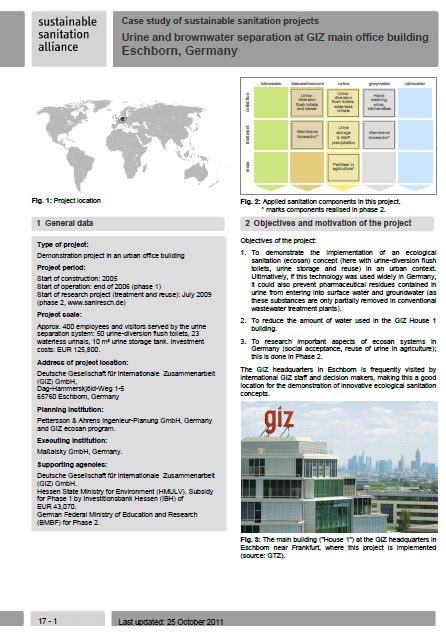Urine and brownwater separation at GTZ main office building Eschborn, Germany - Case study of sustainable sanitation projects
Winker, M., Saadoun, A. (2011)

Published in: 2011
Publisher:
Sustainable Sanitation Alliance (SuSanA)
Author:
Winker, M., Saadoun, A.
Uploaded by:
SuSanA secretariat
Partner profile:
common upload
18192 Views
643 Downloads
Location of library entry
Content - Summary
This case study is about a demonstration project in the headquarters of GTZ in Eschborn, Germany. The project consists of 50 urine-diversion flush toilets, 23 waterless urinals and 10 m³ urine storage tank.
Objectives of the project:
1. To demonstrate the implementation of an ecological sanitation (ecosan) concept (here with urine-diversion flush toilets, urine storage and reuse) in an urban context. Ultimatively, if this technology was used widely in Germany, it could also prevent pharmaceutical residues contained in urine from entering into surface water and groundwater (as
these substances are only partially removed in conventional
wastewater treatment plants).
2. To reduce the amount of water used in the GIZ House 1 building.
3. To research important aspects of ecosan systems in Germany (social acceptance, reuse of urine in agriculture); this is done in Phase 2.
The GIZ headquarters in Eschborn is frequently visited by international GIZ staff and decision makers, making this a good location for the demonstration of innovative ecological sanitation concepts.
The GIZ ecosan team regularly conducts guided tours through the facilities. A demonstration room with various urine-diversion toilet models from all over the world is adjacent to the urine storage tanks.
Due to the complete renovation of the buildings facade and the use of energy efficient heating systems and boilers the energy consumption of House 1 was substantially reduced. The new ground design and a green roof (about 50 % of the total surface) enhance a positive microclimate and reduce rainwater runoff.
The following impacts of this project can be highlighted:
1. This project demonstrates the feasibility of urine and brownwater separation in an urban context to visitors from all over the world and thus helps to disseminate the ecosan concept.
2. By introducing an innovative sanitation system at its own main office building, GIZ shows its commitment to the ecosan approach.
3. The waterless urinals save water compared to conventional urinals.
4. This project has raised the visibility of the ecosan program within GIZ.
Bibliographic information
Winker, M., Saadoun, A. (2011). Urine and brownwater separation at GTZ main office building Eschborn, Germany - Case study of sustainable sanitation projects. Sustainable Sanitation Alliance (SuSanA)
Filter tags
Case studies in SuSanA template English Europe & Central Asia Urban (entire city)















